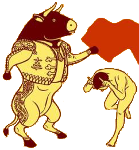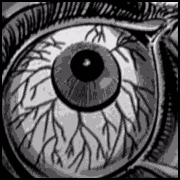|
landgrabber posted:how can i get better at moving around the neck/playing notes faster? anything specific? so there's a few axes i view moving around the guitar on, here's a graphic. A is red, B is blue, C is green.  A is the most common imo, and i generally navigate it in the form of interconnected 3nps scale boxes. you probably know these, but if you can't comfortably flow from one to the next, especially when g-b major third happens, this is a good thing to focus on. i was taught an exercise i still do a lot where i'll play seventh arpeggios with alternating notes in different boxes (IE root in first box, third in second, fifth in first, seventh in second). you can do this with a single chord, or a progression. you can extend it over more boxes, add more extensions, or shift to boxes that are built off a different scale degree (I and bvi or i and III are good ones to start with, since that's major/relative minor and vice versa.) the point is to be able to have scale tones accessible in different ranges that you can grab from elsewhere easily, and melt the shapes together like you left them out in the sun. B is all intervals, and knowing how to orient yourself and move in A or C again once you're done with straight vertical movement. pretty easy to practice, just play melodies on a single string and have a firm grasp of where everything is. do as many leaps greater than an octave as you can; i was always way more comfortable below the 12th fret than i was above it. C is the same as A conceptually, but i've always found it way less natural, and i've been focusing on playing in that direction more lately. it's easy to play root position arpeggios that direction since they tend to kinda fall on or next to a diagonal line going that way; start with those, and try to link the surrounding scale degrees to their neighboring chord tones.
|
|
|
|

|
| # ? Jun 9, 2024 07:31 |
|
Armacham posted:Added a little finishing touch to the amp I built. Awesome, what type of amp is it based on? fullroundaction posted:I am once again here with the best riffs ... this time from 1997 (as picked by my friends). Really cool. I always forget that the foo fighters actually wrote some good tunes once upon a time
|
|
|
|
field balm posted:I always forget that the foo fighters actually wrote some good tunes once upon a time Yeah me too. I was a big nirvana fan but that never translated to Foo Fighters at the time. I knew the radio hits but that's about it. Only recently did I realize that those older albums are actually pretty great!
|
|
|
|
field balm posted:Awesome, what type of amp is it based on? It's basically an AA763 champ, except with an el84 output instead of a 6L6 there's also a toggle for a mid boost, a bright channel and a "turbo" cap bypassing the tone stack.
|
|
|
|
creamcorn posted:so there's a few axes i view moving around the guitar on, here's a graphic. A is red, B is blue, C is green. i have never had a guitar lesson (and can't afford one atm. i can barely afford to pick up my meds these days) so B is actually the axis i'm most familiar with. i've very rarely practiced scales systematically or learned actual lead work-- i just generally know where notes are in the key i'm in and improv a lot. now i'm trying to actually properly learn scales and lead stuff and train my ear for things and it's really hard.
|
|
|
|
McCoy Pauley posted:I have an Aeros Loop Studio, and it certainly delivers on the visual indicator front, and between the touchscreen, foot controls, and ability to connect another foot controllers, it's pretty easy to control everything. It's kind of more looper than I really need, and maybe I should have gone for something simpler when I moved up from RC-1, but I got a good deal on a demo model at Sweetwater during a moment of weakness, and here I am. Yeah that one's a tough sell for me at the current price it's at. I think I'm going to try to get a hold of a used RC5 and see how that goes. I get the feeling that singular is a very small company. I emailed them about getting a replacement adapter for my beat buddy mini and the guy who emailed back made it seem like he was personally responsible for mailing out the replacement. I do really like my beat buddy tho!
|
|
|
|
landgrabber posted:i have never had a guitar lesson (and can't afford one atm. i can barely afford to pick up my meds these days) so B is actually the axis i'm most familiar with. i've very rarely practiced scales systematically or learned actual lead work-- i just generally know where notes are in the key i'm in and improv a lot. Do sixes
|
|
|
|
learn caged major scale first imo, thats basically what lessons teach you. scales are a grind... they do help though. I have trouble with boutique scales in a live setting, I mostly rely on knowing/feeling chords and hitting tones along the major scale, which is basically going through the modes without having to think about it. caged is what they taught me in jazz guitar lessons I think.. they didn't call it that, but it looks the same. basically 6 or 7 positions you can anchor with your middle finger as root, gives you access all over the fretboard. ethanol fucked around with this message at 04:39 on Aug 28, 2023 |
|
|
|
Scales and modes can be less daunting when you realise that in pretty much all popular music there is kinda only one 'pattern' and all that changes is the root note position. As an example, https://www.guitarscale.org/e-minor.html if you look at the full fretboard layout of E natural minor (a reasonable starting point because all the open strings are in the scale with the bottom E as the root, it's a guitar's 'home' key and a bazillion songs are in it) you'll see all the notes you can play in every position on the neck. Learn the patterns and what it feels like to play the scale at fret 0, 3, 5, 7, 9 and 12 (12 is 0 again, I started at 12 first as a kid because I had small hands). That's the hard part, committing those patterns to memory, but you don't have to do it all at once. Learn the scale at 12 and you can already play a solo, add 9 and 3(15) and you have reached the limit of most rock guitarists' solo ambitions. You can then explore the patterns below that and build your muscle memory one position at a time. Then start moving between them, slide up a position, down a position, hop down two etc. Congratulations, you now know how to play E natural minor (Aeolian mode), G major (Ionian mode), A Dorian, B Phrygian, C Lydian and D Mixolydian everywhere on the neck. What does that mean? It means those same notes played with a different tonic (starting or 'home' note) will give you different flavours. So, E nat minor and G major are the same thing (this is known as 'relative' major/minor) just starting the pattern on a different note. One of the easiest ways to feel this is by droning chords and playing over them, if you have a looper or record a single chord into your phone or something and let it repeat, do this with an E minor chord and play notes of this scale and it'll sound kinda melancholic, you'll feel like you want to bring your phrases 'home' to the E. Do the same thing, noodling around the exact same notes, but over a G major chord, you'll want to bring your phrases home to the G and it'll sound more upbeat. It's the same notes and patterns though, you inject feel into it by where you start and where you finish each lick or phrase. (However, you can play E minor flavoured licks over the G chord and G major flavoured licks over the E chord, it'll still sound good because everything is diatonic, meaning all the notes exist within the key, the way you choose to deploy them is up to you. You can also play these notes over any chord that consists of notes existing within this scale, so A minor, C major, B minor, etc etc. Are the notes of the chord in the scale? You're diatonically good to go). Ok so you've got E/G relative minor/major and all the 'G major modes' just from learning one pattern on the fretboard. Good news is this means you pretty much know all scales (for the purposes of this post at least). By shifting these patterns up and down the neck (keeping them the same relative to one another) you can play all of the major scales, all the natural minors, all the modes of each. It's always the same patterns relative to one another. Move the E minor 0 fret pattern to fret 5? That's A minor (or C major). Move it up to fret 7 it's B minor (or D major), etc. All the other patterns you learnt in the different positions shift with it, but it's the same muscle memory to play them. This is a really long and perhaps useless post, obviously there is a ton more to learn, both in terms of scales that don't fit the Ionian/Aeolian pattern as well as how you might shift between keys and modes within a lick or phrase, how you omit or add notes to get different feels (for example the blues pentatonic is the Aeolian minus the 2nd and 6th, essentially). Pretty much all popular music is covered by knowing these/this scale pattern though, and it really doesn't take that long if you take it in bitesize chunks. Edit: this was aimed at Landgrabber but I was scrolled up, later posts might indicate you're already beyond this stage but oh well. Tommy the Newt fucked around with this message at 07:23 on Aug 28, 2023 |
|
|
|
Lol if you learn music theory instead of just brute forcing your melodies on the piano role in a cracked copy of FL Studio. lmao (excellent explainer post btw)
|
|
|
|
Tommy the Newt posted:Scales and modes can be less daunting when you realise that in pretty much all popular music there is kinda only one 'pattern' and all that changes is the root note position. if you go to a scale on this website and click shapes it gives you positions. this is much closer to what my jazz teacher taught me than CAGED I think. importantly it gives you the finger positions. note shape 1 '2nd position' of the g major scale. this is the one my guitar teacher was adamant if you can only learn one major scale position make it this one. the root is starts on your middle finger. note that it lines up so your index finger is 2nd fret, middle 3rd fret, ring 4th and pinky 5th. If you do that with all the positions it gives you a nice anchor for each position to remember in muscle memory. if you learn how to blend pentatonic (hint it's already in the scale) into those exact same shapes you can get a LOT of tonal options out of that. 
|
|
|
|
Yeah, to elaborate one thing about pentatonics is how, if you look at each of those positions in the G major/E minor scale ethanol is talking about, the first pentatonic minor shape everyone learns: Actually 'slots' perfectly into three different positions in that key. What I mean is you can play around with this basic starter 'shape' at fret 0/12 (first position) at fret 5 (fifth position, on the A) and fret 7 (seventh position on the B) and in each position all the notes of this pattern will be diatonic (in the key of G major/E minor). This kind of thing is just a small way of chipping away at what you're learning incrementally while having as much fun as you can. You can really put that basic shape to work for you early doors, and build out from it. Let's say you're jamming to some chords, A minor, C major, G major, E minor, all chords that are diatonic (completely in the key we're talking about) you can take that one 2-note per string pentatonic shape up and down the fretboard and get a lot of bang for your buck. It's also a pretty easy way to figure out what key a song is in, if you can locate that 1, 5 and 7 pentatonic layout on the neck. You might be surprised by how many songs just pick a key and stay in it, once you've found it you're free to noodle. (It's also often a good way to change keys when you're starting out, play the same riff at fifth position and then make that the tonic anchor, for example, or you're playing E minor blues pentatonic at the 12th fret and throw in some '5th position pattern' notes to it to make it Dorian sounding, even over the same chords.) Tommy the Newt fucked around with this message at 14:27 on Aug 28, 2023 |
|
|
|
Interesting. Having some light bulbs go off by seeing how these relate to CAGED and playing a G Major chord in each of these positions. How does the thread feel about tab books. I've picked up a couple for bands I like, but they almost feel *too* accurate (A Paul Westerberg book and a Dino Jr one), and I'm having to reinterpret them to split the difference between multiple guitar tracks. I'm wondering if this is worthwhile at all, or if at this point I should take some simplish songs I like and try to transcribe them by ear. That would take some trial and error, but would be productive, I think. I think I'm digging a bit of a rut for myself by practicing exercises and stuff as an excuse to stop myself playing songs, because I might play the songs badly, if that makes sense? Disco Pope fucked around with this message at 14:32 on Aug 28, 2023 |
|
|
|
Disco Pope posted:Interesting. Having some light bulbs go off by seeing how these relate to CAGED and playing a G Major chord in each of these positions. Iíve found tab books useful for getting specific lists of notes, but I find a lot of times tabs arenít always transcribed in the most ideal place on the neck for how I play ergonomically and whatnot, for me they can be a good jumping off point when theyíre accurate.
|
|
|
|
Don't you love when the tab books/sheet music is in the wrong key
|
|
|
|
tbh I subbed to ultimate guitar pro and it has some really excellent offical tabs there for popular songs. and also separates out the band parts.. like even drum notation sheets so I can punch drums into logic midi, add some synth work, get some decent backing of my own making. it's far more useful than I imagined
|
|
|
|
Armacham posted:Don't you love when the tab books/sheet music is in the wrong key Oof! Yeah, I think using them as a springboard is the way to go - I think "perfect" can be the enemy of "good" sometimes and a form of procrastination to avoid leaving comfort zones.
|
|
|
|
Disco Pope posted:Oof! Yeah, I think using them as a springboard is the way to go - I think "perfect" can be the enemy of "good" sometimes and a form of procrastination to avoid leaving comfort zones. Yes. Don't spend all day waxing your board. https://www.youtube.com/watch?v=P3cFpasEnNM
|
|
|
|
Electra is here, and I'm pretty sure these are original Fender Wide Range HBs No date stamp, but everything else checks out. Slot head screws for the bobbins, base inset from the cover, flipped pole pieces for the ones under the cover. Not sure if the red S/5 means anything. Both are the same. Oh, and the neck is kinda crazy. 3 piece with a flame maple center section, and some ont he fretboard, too.    Now I need to go back to work, then come home and put strings on then figure out what I'm going to do with it!
|
|
|
|
Electra were made by Matsumoku, right? The three piece neck was very much their thing from memory.
|
|
|
|
Disco Pope posted:Interesting. Having some light bulbs go off by seeing how these relate to CAGED and playing a G Major chord in each of these positions. Songsterr.com is great for tabs. Lots have separate tabs for multiple guitar tracks and a playback option that is super helpful.
|
|
|
|
caged shapes don't feel insanely moveable to me i guess. i should learn them though. i never learned pentatonics because they don't have any of the thrilling notes. i love the 4th degree and the major 7th. i write them into everything, it's just what my ears gravitate toward. so running scales without them or playing melodies without them has kind of never been super interesting to me before recently. it's only been then that i've looked at more tab for lead stuff and realized that a simple skip or leap that can be done pentatonically in the right place in the music can be absolutely beautiful. but i love my stepwise motion for sure
|
|
|
|
knowing when to add the 4th or switching between sharp flat 3, 7, 5 is sort of part of the beauty of mixxing major/minor pentatonic with the full major scale. its a way to ease the memorization while still being in the right place to make a change to one of the degrees by feel. you're right if you play pentatonic as written only it's rather bland
|
|
|
|
I swear to god, I love metal and metal guitar sounds, but electric guitars are always looking for ways to sound like pieces of shits. I'm nervous to even plug it in a lot of times. Today it's pick chirp. It's not a new problem. I just had the audacity to plug in and try playing in the higher register today. Used a couple different guitars, multiple picks(Alligator jazz III, nylon Jazz III, round thin picks, the BHL ultam pick I have, etc), different settings and presets, lower amounts of gain, changed pickup height a bit(it's sitting around 2.5mm under the string when depressed at 24th fret). I also tried adjusting input gain/INST on my scarlett solo as well. Tried picking flat against the strings, at my normal fast speed angle, at extra almost perpendicular angle, etc. I tried killing 2k, 4k, 8k, 16k in the sim. Is this a normal amount of pick chirp? I think this is the most reasonable level I've gotten the chirp down too. I've never heard it when other people play. The only thing I think I didn't change yet was the amp sim, I'm using Gojira. https://www.youtube.com/watch?v=OxSdZQ5L_7M Sorry for the nipple, I'm depressed.
|
|
|
|
yeah i guess the way a lot of people get into chromatic stuff is through that. i backdoor'd into it on guitar by reading schoenberg actually and figuring out the "proper" way to resolve altered tones and what they imply and just using that on guitar. probably would've been quicker to just get into pentatonic scales in like week 1 of guitar back in 2018 but you know. that was a big thing for me recently. essentially the way i know the fretboard doesn't come from scales and scale practice but it actually comes from thinking about my chord shapes a lot, doing little decorations, and kind of trying to voice lead stuff. like if i play a chord shape a lot, i usually end up learning its structure and knowing what note is under what finger. i started it almost unwittingly just because i liked different colors and doing suspensions and anticipations in the guitar chords and stuff. and i tend to translate stuff to note names in my head so i can tell you that if i play a G barre chord on the third fret, the B note is under my middle finger. it's all kinda goofy but it's gotten me this far. the weird wrinkle is that to my understanding, lots of guitarists have the opposite problem i do with lead stuff where they have trouble breaking out of a couple vertical boxes. since i never learned those, i just knew the scale formulas in my head, playing them horizontally was always more natural-- so i tend to do weird horizontal jumps that would be easier to do vertically, that sort of thing. my issue with practicing pentatonic scales is that if i practice a full major scale, i can goof around in it for a little bit and get something that sounds like something-- the 4th and the 7th very readily create a tonality, but pentatonic scales are more ambiguous at least to my ears, which makes it harder to kind of have fun in it without chords in the background.
|
|
|
|
Drunk Driver Dad posted:I swear to god, I love metal and metal guitar sounds, but electric guitars are always looking for ways to sound like pieces of shits. I'm nervous to even plug it in a lot of times. Today it's pick chirp. It's not a new problem. I just had the audacity to plug in and try playing in the higher register today. Used a couple different guitars, multiple picks(Alligator jazz III, nylon Jazz III, round thin picks, the BHL ultam pick I have, etc), different settings and presets, lower amounts of gain, changed pickup height a bit(it's sitting around 2.5mm under the string when depressed at 24th fret). I also tried adjusting input gain/INST on my scarlett solo as well. Tried picking flat against the strings, at my normal fast speed angle, at extra almost perpendicular angle, etc. I tried killing 2k, 4k, 8k, 16k in the sim. Sounds like a guitar to me.
|
|
|
|
Drunk Driver Dad posted:I swear to god, I love metal and metal guitar sounds, but electric guitars are always looking for ways to sound like pieces of shits. I'm nervous to even plug it in a lot of times. Today it's pick chirp. It's not a new problem. I just had the audacity to plug in and try playing in the higher register today. Used a couple different guitars, multiple picks(Alligator jazz III, nylon Jazz III, round thin picks, the BHL ultam pick I have, etc), different settings and presets, lower amounts of gain, changed pickup height a bit(it's sitting around 2.5mm under the string when depressed at 24th fret). I also tried adjusting input gain/INST on my scarlett solo as well. Tried picking flat against the strings, at my normal fast speed angle, at extra almost perpendicular angle, etc. I tried killing 2k, 4k, 8k, 16k in the sim. you're hearing a guitar in solo context where that's gonna pop. in a mix it's not as important or prevalent don't worry about it
|
|
|
|
I learned pentatonics, and especially the minor pentatonic, first. I tend to think of those notes as more concrete in my solos and am more likely to play around with the other two notes in the scale to create a little modal ambiguity or have little chromatic runs. If I'm playing a song in a natural minor I might throw in a few b-flats and f#s to have repeating figures in different places or if I want it to be a little squishy about if a section is more d natural minor.
|
|
|
|
muike posted:you're hearing a guitar in solo context where that's gonna pop. in a mix it's not as important or prevalent don't worry about it Alright, cool, thanks. I also noticed super high up past 12 is where it's noticeable anyway. If I go down some frets it's not quite as bad.
|
|
|
|
Came for the guitar, stayed for the nipple. Sounded good to me
|
|
|
|
landgrabber posted:yeah i guess the way a lot of people get into chromatic stuff is through that. It's tempting to draw too rigid lines between some of these concepts, when really it's kinda all the same. All chords are made up of notes from some scale, they're the same notes played simultaneously, and pentatonics are the same scales, just with holes in them. That's why my suggestion for people wanting to 'open up the fretboard' is still basically the boring 'learn your major scale patterns', because then you are armed with everything you need to play 95% of all popular music, both lead and chords. Then you can go to a jam session and someone can say 'we're in C minor' and you'll immediately know every note on the fingerboard you can safely play, by extension all the diatonic chords you can play, as well as a bunch you might be able to play outside of that (by trying complementary modes, for example). Not that all music adheres to a single major key, but a shitton of it does, and when it doesn't it'll probably just be shifting those patterns around a little so the muscle memory you learn from playing those scale positions sets you up very well. I only mentioned pentatonics because it takes less time to learn those shapes and get up and running, not because I was suggesting you stop there or treat them as their own thing, it's just faster to learn and apply 2 note per string patterns than 3, and they are reliable shapes you can anchor yourself with and hang other modes off. That minor pentatonic shape, the hand position if you like, forms the backbone of the Aeolian, Dorian and Phrygian modes and therefore occurs in 3 positions on the board for every major scale, they can then be embellished with different 4ths and 7ths etc to your heart's content. It should be a landmark rather than a restriction. I dunno if that makes any sense, but I've never really understood the way guitar teaching tends to compartmentalise chord work and linear work. To me, if you know where all the notes are for a given key there's nothing stopping you playing them simultaneously as well as individually. If you're a visual learner, you can look at the map of a scale and literally see the chords in it. I will add the caveat that, while I believe it's a system of landmarks rather than a restriction, in practice it can end up feeling like a restriction if you get too rigid about it, or when you're learning and don't have the courage of your convictions to leave diatonic safety. Not everything is diatonic, nor should it be. I don't really have a solution for that other than keep playing loose and don't be afraid to try stuff. I know some people prefer to just think purely in individual intervals at any given moment and I can see the logic of that, but I think you need a particularly good ear to make that work for you, kind of like learning a language just from travelling and listening vs learning the grammar and applying it, it depends how much time you have and how good your ear is. I dunno why I'm waffling so much today, like I'm some self-styled expert - I have no credentials and am just killing time while trying to make a 3-month-old sleep so take everything with a pinch of salt obviously.
|
|
|
|
Drunk Driver Dad posted:Alright, cool, thanks. I also noticed super high up past 12 is where it's noticeable anyway. If I go down some frets it's not quite as bad. The other thing you could do if your DAW had a decent EQ you could sweep a very narrow high gain band and see where that noise is really jumping out and then cut that frequency. I don't really think it's that bad though.
|
|
|
|
Baron von Eevl posted:The other thing you could do if your DAW had a decent EQ you could sweep a very narrow high gain band and see where that noise is really jumping out and then cut that frequency. I don't really think it's that bad though. I don't know a ton about that stuff, but as long as things are okay and it won't stand in the way of me eventually getting around to making a cool little mix I'm not too worried about it in terms of it annoying me. I haven't noticed it before on other videos of people playing, but I'm also probably not really looking for it during the times someone happens to alternate pick fast in the higher register either
|
|
|
|
You're just not really going to hear it in a mix, and what you do hear will sound completely fine.
|
|
|
|
Play along to some drum tracks and I bet you don't notice it.
|
|
|
|
the only time ive ever noticed pick chirp is on this record, where it sounds like they went out of their way to make it fifty times louder lol. i guess its a hm2 thing https://www.youtube.com/watch?v=QWHXztcZoIo
|
|
|
|
New thread titleDrunk Driver Dad posted:Sorry for the nipple, I'm depressed.
|
|
|
|
P0PCULTUREREFERENCE posted:New thread title
|
|
|
|
Drunk Driver Dad posted:I swear to god, I love metal and metal guitar sounds, but electric guitars are always looking for ways to sound like pieces of shits. I'm nervous to even plug it in a lot of times. Today it's pick chirp. It's not a new problem. I just had the audacity to plug in and try playing in the higher register today. Used a couple different guitars, multiple picks(Alligator jazz III, nylon Jazz III, round thin picks, the BHL ultam pick I have, etc), different settings and presets, lower amounts of gain, changed pickup height a bit(it's sitting around 2.5mm under the string when depressed at 24th fret). I also tried adjusting input gain/INST on my scarlett solo as well. Tried picking flat against the strings, at my normal fast speed angle, at extra almost perpendicular angle, etc. I tried killing 2k, 4k, 8k, 16k in the sim. I barely hear or notice what you're talking about. It's fine.
|
|
|
|

|
| # ? Jun 9, 2024 07:31 |
|
your depressed nipple has brought you fame ddd what will you do with it
|
|
|































